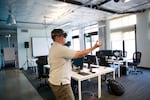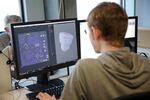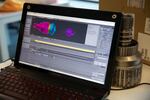
A student wears the Microsoft HoloLens headset and pinches the air in order to "select" an option within the headset's menu.
Shirley Chan / OPB
A virtual trip to the pyramids? An interactive hologram of the universe?
Virtual and augmented reality has the potential to transform the classroom and how we learn everything from history to astronomy to engineering.
Take, for example, the transmission of a car. Like many complex systems, it’s a beast to teach. To understand how it works, students have to take it apart and then rely on their imaginations to picture how all the disassembled pieces fit and operate together once turned on, with many parts spinning at multiple speeds in multiple directions.
“I probably go over power flow in an automatic transmission, I kid you not, probably 200 times a term with students, over and over again, individually, as groups, in the classroom,” says Clackamas Community College automotive instructor Rick Lockwood. He relies on textbooks and an actual transmission he has sitting in a wooden cradle in the shop. He can slide the components off to show other parts inside them and how they interlock and drive each other, but the result is often a table littered with gears and confusion.

Could holograms make learning a complex system like a transmission much more accessible?
Courtesy of Oregon Story Board
What students really need is X-ray vision, which is why Lockwood jumped at the opportunity to participate in a collaboration between Clackamas Community College and the nonprofit tech incubator Oregon Story Board. The two applied for an academic research grant from Microsoft. They beat out prestigious universities to win $100,000 to develop an educational curriculum using Microsoft’s HoloLens.
Unlike virtual reality, which immerses you in a digital world, the HoloLens creates what’s referred to as augmented or mixed reality. Its big, wraparound glasses are a transparent screen, so it can overlay digital images and video to make it appear as though holograms are floating in front of you, which you can then interact with through voice and hand gestures.
Related: Oregon Virtual Reality Incubator Takes Artists Into New Worlds
The technology elevates augmented reality from phone- based apps like Pokémon Go to a level that leaves even jaded inventors filled with “awe and wonder,” says Thomas Wester, who spent years inventing innovative tech at the design studio Second Story.
“It’s really opening up how you think about experiences,” says Wester, as he shows how he can leave, say, the hologram of an astronaut rotating in a corner of the room’s ceiling for anyone with a HoloLens to see. “Things don’t have to be on a screen anymore. So what does that mean for the space? How does your classroom change if there are holograms everywhere?"
Beginning in early 2016, Oregon Story Board brought together Wester and a class of students and professionals to create a holographic transmission and explore how well it functioned as a teaching tool, with the goal of writing a white paper that could influence other schools’ use of the technology.
Relying mostly on the video game development software Unity, they scanned the transmission in 3-D and then worked to turn it into a transparent, color-coded animation. But being that the HoloLens technology was brand new (they didn’t even get the devices until several months into the year), they had to figure things out as they went along, such as how users would control the animation, how to make the parts rotate in relation to each other at appropriate speeds, how to make the hologram hang in a stationary position, and how to make it so multiple HoloLens devices could see and interact with the same hologram.

Clackamas Community College automotive instructor Rick Lockwood (right), with his hand on his transmission model, as he and two students go through the hologram transmission animation with Microsoft HoloLenses.
Courtesy Oregon Story Board
By September, they had only managed to make it through the many parts that go into the first gear, but the animated hologram was enough to make a huge difference for the Clackamas Community College students.
“It’s pretty amazing,” said Eddie Zamora, wearing the traditional blue mechanics jumpsuit with the not-so-traditional HoloLens. “I think this will help me on my power flow for sure.”
When asked what his favorite part is, he replied: “The X-ray part, so I can see all the gears moving.”
In the white paper on the project, Oregon Story Board found that students cut the time they needed to fully understand the transmission from three-to-five weeks to one. It’s the kind of potential that makes educators tremble in delight. Microsoft inked a deal with the textbook giant Pearson to pilot programs at three more universities, and earlier this month it announced a new Windows application called View Mixed Reality.
Related: VR Is Changing The Game For Portland Architecture
“This is my vision,” said Oregon Story Board’s educational program director, Anthony Pires. “You see the students, everyone has a holographic headset, and as the instructor, I can pull up the solar system and all of you see what I can control. So we can then critically think about everything and go through those steps together. So learning is much more dynamic. It's not the teacher lecturing and the students on a cell phone looking down. It's now, I now have an immediate tool to engage you.”
It’ll likely be years before HoloLenses are widespread in classrooms, but right now students can use cell phones and basic VR headsets like Google Cardboard to immerse themselves in 360-degree photos and videos of far off places.
“The content on a mobile phone can be phenomenal,” said Oregon Story Board’s executive director Shelley Midthun. “I love the idea of having students in whatever way being exposed to different humans around the world, different places around world. Literally expanding horizons is endlessly interesting to me.”
Oregon Story Board is trying to position itself on the front lines by teaching some of the first classes in the country on how to create content for HoloLens and the many virtual reality headsets. Summer courses begin June 5 and are open to experienced programmers and beginners alike.






